Medieval Tavern 28 mm Miniatures
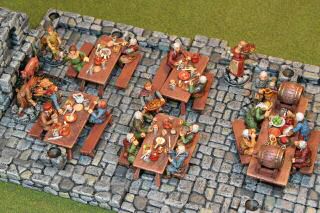 |
| Full house at the tavern |
This article describes the painting of a 28 mm scale miniature medieval tavern scenefrom Mirliton.The Mirliton "Tavern Kit 10" includes 20 human figures, 5 fully loaded tables,10 benches, a few kegs, some roasting food, and a hungry dog.In fact everything shown in this photo, except the gray stone basing and the greenbackground, is included.Overall, it makes a nice lively scene for dioramas, role playing games,and historical miniature games.
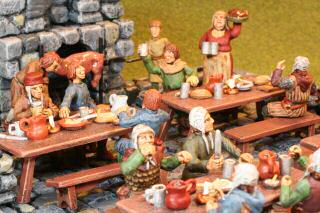 |
| A toast to our roast pig |
The human figures come in multiple parts.Typically, you get a torso, two arms, and a pair of legs.There are only one or two pairs of duplicated torsos,so combined with the assembly, there is quite a bit of variation.Notice the expressive sculpting in the figures.They have expressive faces and animated gestures.Assembly is quite tricky.I found cyano-acrylate super glue to be too weak, so I usedtwo-part resin epoxy.It helps to clean the miniatures and rough all mating surfaceswith an emery board or scoring with a razor knife.You can use some putty to hold the figures in place as the epoxy dries.Sculpy III and Silly Putty are low on oils and residue, but ithelps to wash the figures before priming and painting.
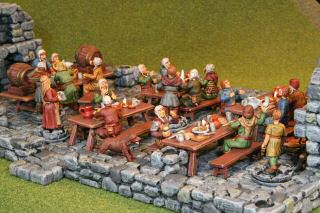 |
| Kegs over here |
The kit contains five tables, ten benches, anda big assortment of dishes, pitchers, cups, candles, and utensils.Each table is cast plain, so you can decide what to do with each.I decided to scatter the serving dishes and place settings aboutevenly across the tables.Cheeses, meats, breads, trenchers - the tables are quite full.I primed and painted the tables first,primed all the table items, glues the items to the table, and then finished paintingthe table items.The pieces are quite small, so gluing them to the tablemade a handy holder for the fine detail work.
The standing figures in this Mirliton kit have no molded bases.So I constructed resin bases to look like the floor.
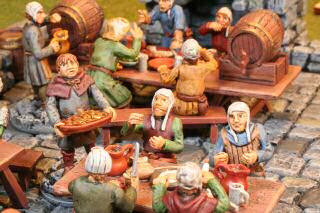 |
| The militia comes here often |
This table appears to be frequented by the local militia.They are not armed, but they all wear arming capsand armor.The tavern worker brings a nice tray of defectable goodies.I painted these figures in my usual manner with Vallejo acrylic paints.Each figure gets the basic flesh tones and clothing blocked in.Then the highlights are drybrushed.Then the details such as belts, caps, hair, and shoes are added.Finally, I wash the figures with MinWax Polyshades polyurethane stain.Some people call this "Magic Wash".Apply liberally with a disposable brush, and remove the excess with a cotton swap or paper towel.The MinWax stain is very fine pigment and a very consistent density.It dries slowly, so you can adjust the shadowing to the intensity you like.What you see wet is very close to what you see dry.I find the MinWax product much more controllable and repeatable than acrylic inks and washes.
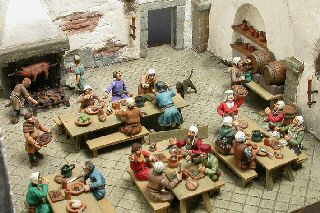 |
| The Mirliton site paint scheme |
Here is an alternate paint scheme that appears on the Mirliton site.This painter (Grazzini Stefano?) has chosen lighter tables and different tunic colors.The scene has beautiful custom sculpted floors and walls.Whatever you choose, the scene very readily becomes unique and interesting.
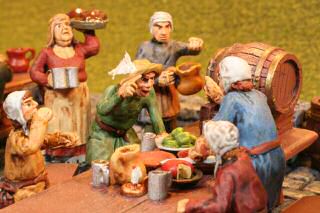 |
| A kegside debate |
At this table there are a few of my favorite figures.The two standing men are pointing fingers, shouting, and making a strong debate.I added a feather to the one man's straw hat, although it looksa bit mishapen from this angle.In the back is the beer matron with a platter of poultry and two hefty mugs.But she looks strong and non-chalant about all the weight.The other worker draws a beer from the keg. He looks scowling.
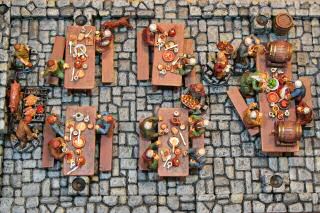 |
| Overhead view |
Here's an overhead view of the whole scene.Here you can see exactly how many bits and pieces are placed on the table.There are so many figures and tables that this kit did noteasily fit in my existing Ale Knights Pub building.The stone foundation forms a partially completed banquet hall.I use Hirst Arts plaster fieldstone pieces for my tavern.Later beams and wattled walls will enclose the hall.Large crucks and rafters will put a thatched roof over their heads.
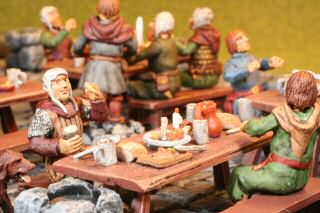 |
| Feed the dog |
Here's another close up.In the lower left, the dog begs for his supper.Nearest the viewer is a trencher board with some food on it.These boards were often made of breadthat you could eat after all your meal soaked and softened it.However, many people gave the trencher to a beggar or dog.This brown dog knows from where his supper comes.Photography at this close can be tricky.The closer you are to your figures, the more the depth-of-fieldshortens.It is best to photograph with lots of light and extremelysmall apertures.Either shoot outside on a cloudy day (so no direct sunlight causes harshshadows), or turn on all the lights in the room.Don't use on-camera flash as this will tend to burn the nearby figuresand leave the rest of the figures in the dark.Use manual settings to control your aperture and exposure.To get small apertures (e.g. F22 or F32), use long exposures.Don't worry, the figures won't move.Always use a tripod or set your camera on the table topto avoid camera shake.
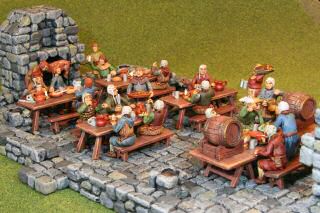 |
| Feed the dog |
Thanks for visiting and reading about my Mirliton Tavern figures.I hope you enjoyed reading the details of making and painting them.If you have a similar kit, I would be interested in seeing your version and the ideas you used to make the scene.More miniatures-related articles are atDan Becker's Miniatures and Models site.









